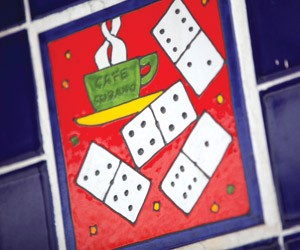They are unique features of many big cities—the micro-neighborhoods that add flavor to the whole but might be overlooked by visitors intent on checking off a list of major tourism spots.
In extreme South Florida, Miami has many such mini-destinations, including one that has never been the same place twice: Little Havana. As its name implies, Little Havana was a small slice of home created by Cuban exiles fleeing Fidel Castro's regime and starting over 200 miles to the north. However, it has evolved to include scores of people from all over the Americas, including Nicaragua, Honduras, Colombia and Peru.
"Each nationality has its own contributions, and together they create a new culture, Miami-style," notes Fernando Dominguez, a representative for CAMACOL, the Little Havana-based Latin Chamber of Commerce. "There are a lot of artists here, a lot of galleries and shops selling unique crafts and decorative items."
And then there's the food—meat pies and fried dough dusted with sugar, savory sandwiches of ham and turkey pressed flat for maximum crunch, fresh plantain chips and rich tamales.
Groups will want to save time to wander the cobblestone streets, perhaps visiting a cigar factory to watch the experts hand-roll cigars before stopping at an open cafeteria window for a shot of sweet, fragrant cafe cubano or fresh coconut juice.
If your group is in town in March, and you don't mind crowds, the Calle Ocho festival is billed as the world's largest street party, filling 23 blocks of Little Havana's S.W. 8th Street with more than 30 musical stages and hundreds of street vendors.
Heading up the road from Fort Lauderdale, a town that hasn't stopped growing, is Lauderdale-By-The-Sea (LBTS), an oceanside enclave known as "the town that refused to grow up." The nickname is a reference to building height.
"Everything here is low-rise so it doesn't block the ocean," says Steve d'Oliveira, the town's public information officer. "Our predominant architectural style is Miami Modern, or MiMo, which gives us a 1950s kind of look."
A compact, walkable downtown area also recalls an earlier era in South Florida, with restaurants, pubs and shops centered on Anglin's Square. Newly expanded sidewalks and strategically placed Adirondack chairs invite strolling and relaxing.
"Our town just spent $5 million on a streetscape project to make it more pedestrian friendly," d'Oliveira says. "We put in wider sidewalks for outdoor dining, new palm trees and two new plazas down by the ocean. We created all these neat public places for people to hang out."
Groups can also hang out underwater, if they're so inclined. Just a hundred yards out from the beach is a coral reef that is popular with snorkelers. Lauderdale-By-The-Sea is also home to a collection of classic Florida-style hotels on the ocean, many offering suite or apartment-style accommodations.PageBreak
Heading northwest, one of Pensacola's most historic downtown streets has become the hot place to be. Palafox Street has not only been rediscovered by locals, it was named in 2013 as one of the "10 Great Streets in America" by the American Planning Association, a Chicago- and Washington, D.C.-based organization providing leadership in the development of vital communities.
"The renaissance that has taken place in downtown Pensacola is unbelievable," says Brooke Fleming, communications manager for Visit Pensacola, pointing to a new lineup of cultural entertainment options on Palafox that includes the Mainline Art House and Picasso's Jazz Club, serving lunch and dinner with a side of live music.
"One of the great things about our downtown area is just about every business is local," Fleming says. "Restaurants buy their ingredients from local fish markets and farmers. It's a priority for our downtown restaurants.
Downtown Pensacola is also very walkable, according to Fleming.
"Nothing is too far from anything else, which makes it perfect for dine-arounds," she says. "And groups get a beautiful view of downtown Pensacola and the bay."
Walkability is also key during Gallery Night, a monthly event during which a portion of Palafox is closed to vehicles and people explore local galleries and shops, many of which provide light refreshments. Fleming says February's Gallery Night was co-sponsored by Pensacon (the city's own version of Comic-Con), which took place Feb. 21-23 and was headlined by Peter Mayhew, Chewbacca of Star Wars.
Other Florida cities enhanced by micro-neighborhoods include Jacksonville, with a Riverside district that is listed on the National Register of Historic Places and features Five Points, an artsy neighborhood with funky coffee shops and outdoor cafes, one-of-a-kind shops and nightclubs. Nearby Avondale is known for its antique stores and some of the area's best bed-and-breakfast inns.
To the south and just outside St. Augustine, Vilano Beach looks like it was plucked from Florida's post-war boom and set down in 2014. In fact, new construction must adhere to the Art Deco or Florida vernacular design, says Vivian Browning, president of Vilano Beach Main Street.
"Our goal is to be a small Florida beach town," she says. "We're bringing residential and soft commercial together to keep that small-town feel. And we have height restrictions. There will not be any high-rise condos or buildings."
What Vilano Beach does have is a mere 2,200 feet between the ocean and the Intracoastal Waterway, affording lovely views from nearly every angle. It's also within walking distance of downtown St. Augustine, though Browning says they're working on getting a shuttle or trolley to take people back and forth. Small groups can check out the local Hampton Inn, offering 840 square feet of event space.
Meanwhile, South Tampa's Hyde Park neighborhood is a made-for-strolling village of boutiques and retail offerings, including the Wine Exchange Bistro & Wine Bar, offering more than 40 wines by the glass, and the family-run Toffee to Go. By night, Hyde Park's SoHo entertainment district takes over as people gather for happy hour and to check out such cool hotspots as Ciro's Speakeasy and Supper Club and The Lodge nightclub.






